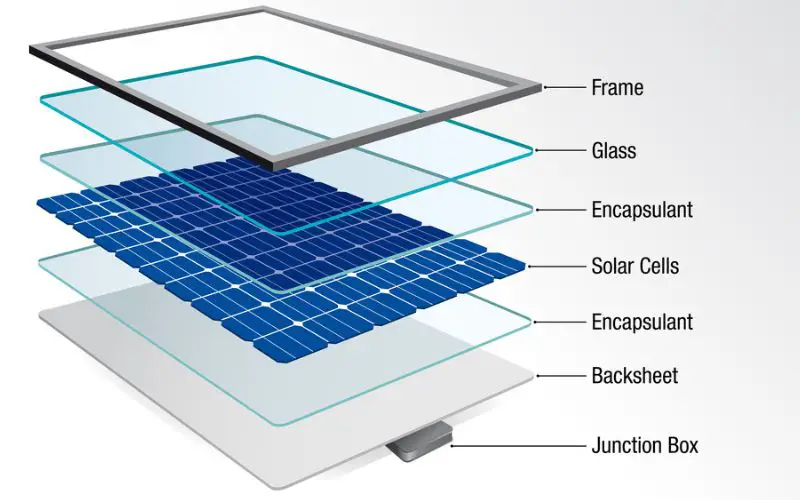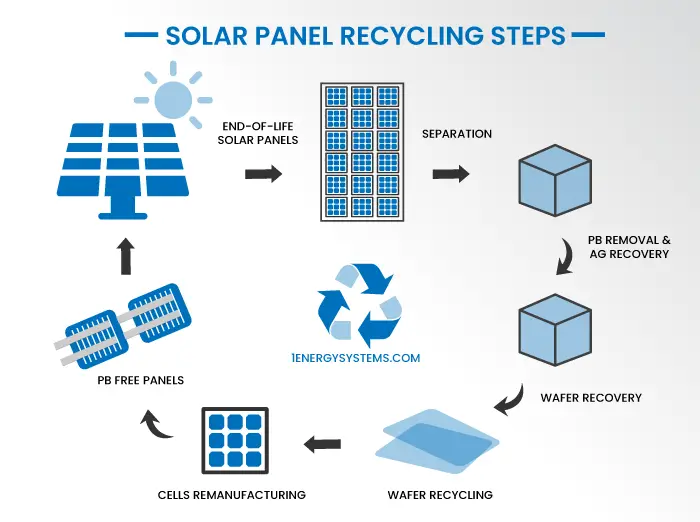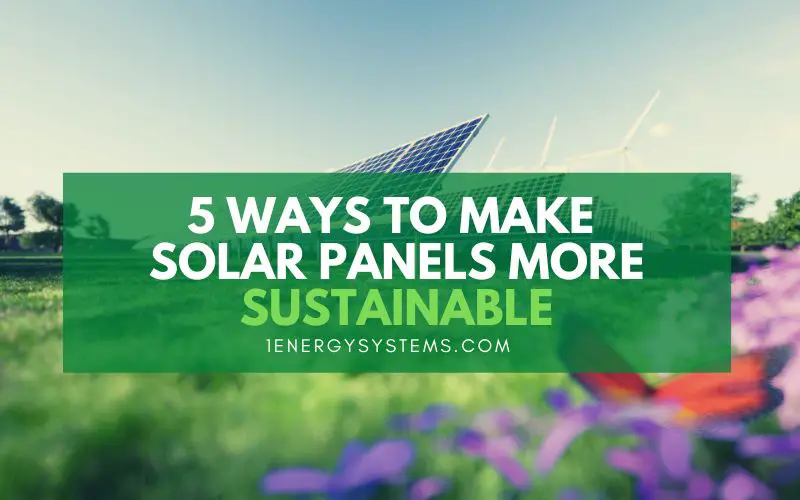Solar energy is the golden boy of the energy industry. Even among renewable energy resources, solar power occupies an exalted position due to its affordability and versatility.
It is considered clean, green, and sustainable besides being a renewable resource. All these epithets are accurate for solar energy and at the same time slightly off the mark.
Why solar energy is not sustainable? How come this can be true when the countries across the world are going all out to promote solar power as a solution to global warming and climate change – the two evils posing threat to our very existence.
Solar power is indeed clean, green, renewable, and sustainable. There are no two arguments about solar power sustainability. The trouble is with the solar panels. They are not so clean or green nor completely renewable and sustainable.
The reason for the not-so-good report on solar panels is due to the materials used in solar panel production, its transportation, installation, and end-of-life disposal. The mining and processing of materials used to make solar panels are neither sustainable nor energy efficient. The cleanness, greenness, and renewability of the process are under a cloud.
In the last decade, solar technology has made big strides in all these aspects. However, the fact remains that so much more remains to be done. This article explores the topic of sustainability of solar panels and comes up with some suggestions for improvement.
Why is sustainability important?
Sustainability is the ability to survive on this planet and manage development in such a way that we can live a comfortable life without taking away the same comforts from future generations.
The term sustainability was first mentioned in the Brundtland Report on sustainable development by the United Nations. It is defined as “development that meets the needs of the present without compromising the ability of future generations to meet their own needs”.
This gains importance with the ever-expanding population putting a strain on the limited natural resources available to us. The ambit of sustainability includes every single one of the natural resources that are limited in supply.
As we all know, solar power is sustainable as well as renewable. Renewability refers to a natural resource that is not depleted by use and can renew itself such as solar energy. As long as the sun is shining, we, on the earth, will continue to receive sunlight. Whether we use the solar energy received or not, the sun will continue to shine. This makes solar power renewable as well as sustainable.
However, the same cannot be said about the solar equipment including solar panels used to harness the solar energy. The materials used in the manufacture of the panels are finite in availability. Silicon is the most common mineral used in solar panel production. Though silicon is available in abundance on the surface of the earth, the crystalline form of silicon required in the production of solar panels is extremely rare.
Another area of concern regarding solar panels is their carbon emission. That is the amount of carbon dioxide released into the atmosphere during various stages of production including mining and processing. Later on, during transportation, installation, and even in the disposal of out-of-commissioned solar panels, more carbon footprints are added.
Most of this comes from the use of coal-powered electricity which has a high carbon footprint. As the world is grappling with the devastating aftereffects of global warming and climate change, the need of the hour is to focus on sustainability on all fronts.
All of these are making solar energy not sustainable.
How to improve the sustainability of solar panels?
Are solar panels sustainable?
As solar panel sustainability is a multifarious issue, the solutions are also manifold. Let’s take a look at some of the implementable methods to make solar panels more sustainable.
1. Extending the lifespan of solar panels
This is a simple and straightforward way to raise solar panel sustainability. Naturally, the longer the solar panels last, the fewer panels need to be manufactured, resulting in less strain on the natural resources used in its production.
Not all solar panels are the same and not all of them come with the same lifespan. The monocrystalline silicon panels come with a life of 25-30 years, while polycrystalline silicon panels usually last for 20-25 years and thin-film panels for 15-20 years.
When choosing solar panels, a buyer needs to consider various aspects before making a decision. Cost is one major factor that goes against monocrystalline panels. Moreover, the single silicon crystal required in its production is hard to procure. This means, from the viewpoint of solar panel sustainability, we need to find ways to extend the lifespan of all panels and not just go with the one having the longest lifespan.
This can be achieved by making the panels better endure extreme weather conditions and damages during transportation and installation. The tempered glass cover provided on the front is aimed at protecting the panel. The addition of a protective glass sheet on the back as well can improve the sustainability of solar panels.
The better protected the solar panels are from damage, the longer their lifespan will be. This translates to lesser carbon emissions and lesser use of raw materials in its production. That is improved solar panel sustainability.

2. Repairing damaged solar panels
The structure of a solar panel is simple. Most of them consist of a layer of silicon crystalline cells sandwiched between two layers of translucent plastic film (EVA) on either side, together with a glass plate in the front and a polymer plastic sheet in the back, and the whole arrangement held together in a sealed aluminum frame.
This design of the solar panel helps it to withstand the vagaries of nature as well as damage due to handling. However, there is no realistic way to rule out damages.
The front glass may break during transport or installation. A heavy hailstorm can also cause cracks in the glass. When the front glass develops cracks, the solar panels are rendered unusable as water can seep in and cause damage affecting its efficiency.
Replacing the front glass is not an option. The entire solar panel needs to be replaced. To minimize this, making the front glass panel stronger and resistant to breakages and damage is the obvious solution.
After being out in the open for long, the back panel and the seal of the solar panel may face slow degeneration. Though this will bring down the efficiency, timely intervention can prevent serious damage. Resealing the back with adhesive paste is an effective solution.
The electric cables and diodes in the junction box can be replaced without much fuss to extend the lifetime of the solar panel.

3. Recycle the solar panels to recover natural resources
In the United States, the recycling of end-of-life solar panels is yet to take off in a big way. However, Europe has proved that this is an excellent way to raise the sustainability of solar panels.
Whether the solar panel has reached its end-of-life phase or if the front glass panel is broken, the solar panel has to be replaced. In both instances, solar panel recycling is a viable option to recover the usable materials or parts. This will bring down the demand for natural resources for panel production as well as reduce the waste generated that goes into a landfill.
In many European countries, old solar panels are repaired and resold. If a solar panel is beyond repair, the usable parts in it such as cables, aluminum frame, and junction box can be removed and reused. The glass panel is recycled to make glass wool for thermal insulation. Plastic foils are burned in power plants to produce energy.
Lead and metals in a solar panel are separated using various techniques and reused for other purposes. Typically, the solar cells are shredded and go into landfills. In rare instances, aluminum and silver are recovered from the cells.
Solar panel recycling is an area that can do with more focus and innovations. There is a lot of room for improvement in solar panel recycling. Instead of turning the glass panel into glass wool, which adds to the carbon emission, the panel may be removed and reused as such in new solar panels.
Recovery of high-purity silicon from old panels for use in new ones needs to be explored and implemented. While at it, the remaining two constituents of a solar panel, silver and aluminum should be recovered from the discarded solar cells without fail. Bringing in a law to make recycling mandatory can help.
The process of recovery and reuse necessitates energy and this adds to the carbon footprint. Efforts should be made to bring down the energy consumption for these tasks.
4. Preventing harm to the environment
Though solar panels pose no real danger to the environment, they still contain traces of toxic substances that can leach pollutants into land and water if left in landfills and allowed to disintegrate on their own.
Lead used in soldering can be harmful though most manufacturers don’t opt for toxic lead. The cheaper thin-film panels contain highly toxic metal cadmium. To prevent causing harm to the environment, all solar panels need to be recycled and the toxic components recovered. Though non-toxic, solar panels can also be recycled to recover copper, tellurium, and silver. If possible, these may be reused or otherwise disposed of safely.
Most European countries have placed the onus of recycling, recovery, reuse, and safe disposal of components of solar panels on the manufacturers. The United States has a lot of catching up to do here.
5. Investing in R&D to raise sustainability
The solar industry and the world countries need to invest more in research and development (R&D) to improve various aspects of the solar panels – their lifespan, use of finite natural resources, use of energy in production, and ease of recycling and recovery of useful materials from decommissioned panels.
In the last decade alone, the solar industry has witnessed considerable improvements on various fronts. Much more can be done to help increase the sustainability of solar panels. Improving the sustainability of solar panels can help in making solar energy even more sustainable.
Bottom line
Solar power is making big strides and increasing its share in energy production. Favorable government policies and public interest are aiding in this growth. Ambitious carbon emission undertakings by governments are filtering down to lower levels, compelling the energy industry to shift its focus from fossil fuels to renewable energy sources like solar power.
As “Going solar” is trending, this is the right time for all concerned – governments, manufacturers, scientists, and consumers – to step up to the plate and do their bit for the planet. It is time we realize that sustainable development is the only way forward.
Recommended Reading:

